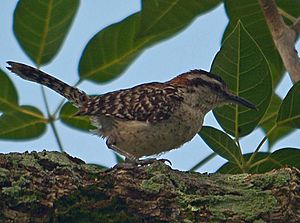Veracruz wren facts for kids
Quick facts for kids Veracruz wren |
|
|---|---|
 |
|
| Conservation status | |
| Scientific classification | |
| Genus: |
Campylorhynchus
|
| Species: |
rufinucha
|
 |
|
The Veracruz wren (Campylorhynchus rufinucha) is a small songbird from the wren family, Troglodytidae. This special bird lives only in Mexico.
Contents
About the Veracruz Wren
What is a Veracruz Wren?
The Veracruz wren is a type of bird that sings. It belongs to a group of birds called wrens. These birds are known for their lively songs.
Where Does This Bird Live?
This wren is found mostly in the central part of Veracruz state in Mexico. You might also find a few in the northern part of Oaxaca. It likes to live in dry tropical forests. It can also be seen in areas changed by people and in coastal mangrove forests.
How Do Scientists Classify the Veracruz Wren?
How Did the Veracruz Wren Get Its Name?
Scientists used to think the Veracruz wren was just one of many types of a bird called the rufous-naped wren. But in 2009, new research suggested that these birds were different enough to be separate species.
So, the Veracruz wren became its own species. It kept the original scientific name, C. rufinucha, because it was named first. Other birds that were once thought to be the same species were given new names. For example, one became Sclater's wren, and others became part of the rufous-backed wren group.
Do All Scientists Agree?
Most bird groups, like the International Ornithological Committee, now agree with this split. However, some groups, like the American Ornithological Society, are still reviewing the changes.
What Does the Veracruz Wren Look Like?
Colors and Markings of Adult Wrens
An adult Veracruz wren has a dark, almost black, head top. It has dark patches near its eyes and a white stripe above each eye. The back of its neck and its main back feathers are a reddish-brown color. Its shoulders have cool black and white stripes.
The tail is gray-brown with darker stripes and a white tip. The bird's chin and throat are white. Its chest is a light, creamy color with brown spots. The belly is a darker cream, and its sides have faint dark stripes.
Young Veracruz Wrens
Young wrens look a lot like the adults. However, the white stripe above their eyes is more of a creamy white. Their back is a duller reddish-brown, and the markings on their back are not as clear as on an adult.
Veracruz Wren Behavior
What Do Veracruz Wrens Eat?
The Veracruz wren loves to eat insects. It hunts for many different kinds of bugs.
Veracruz Wren Breeding and Nests
Scientists don't have a lot of information about when and how the Veracruz wren breeds. But like other wrens in its family, it builds a round nest. This nest has an opening on the side, like a little door.
How Does the Veracruz Wren Communicate?
The Veracruz wren sings and makes calls. You can listen to an example of its song here: [1]. You can also hear one of its calls here: [2].
Is the Veracruz Wren Endangered?
Conservation Status
The IUCN (International Union for Conservation of Nature) has looked at the Veracruz wren. They say it is a species of "Least Concern." This means it is not currently in danger of disappearing.
Scientists haven't counted exactly how many Veracruz wrens there are since it became its own species. But they believe the number of these birds is staying steady. There are no signs that their population is going down or that they face major threats.
Images for kids
See also
 In Spanish: Cucarachero nuquirrufo para niños
In Spanish: Cucarachero nuquirrufo para niños




